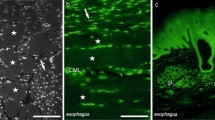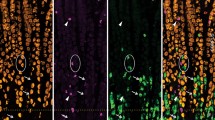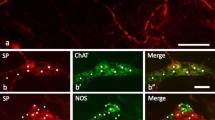Summary
The pyloric ceca (p. c.) of the starfish, Asterias rubens L., are investigated light- and electronmicroscopically.
The wall of the p. c. consists of 1. a high columnar epithelium the basal part of which is permeated by many axons, 2. a basal lamina, 3. a loose layer of smooth muscle cells intermingled with thin nerve fibres, and 4. the coelomic epithelium. Intraepithelial sensory elements are lacking in the epithelium.
The epithelial cells of the p. c. are provided with a very well developed brush border built up by microvilli of equal length and diameter. In addition each cell bears a long cilium (9 + 2 pattern) connected with a periodically structured rootlet. Only single cells are characterized by a more or less irregular seam of plump ramified microvilli. The parallel orientation of microtubules in the apical parts of the cells causes the striation already to be observed under the light microscope.
The intense vesiculation of the cytoplasm and the occurrence of many pinocytotic invaginations on the basis of the brush border is considered to be the equivalent of the high absorption activity of the epithelial cells.
Spheroidal lipid inclusions, mucopolysaccharide granules and large masses of unknown nature are embedded in the cytoplasm of the epithelial cells. Irregularly shaped mucopolysaccharide substances are extruded into the lumen of the p. c. The occurrence of so-called zymogen granules has not been observed in our material.
The intraepithelial axons are closely attached to the basal parts of the epithelial cells without forming typical synapses with membrane thickenings. Apart from neurotubules, the axoplasm of these tiny fibres contains dense-cored vesicles (diameter 1000–1200 Å, 1200–1600 Å) resembling the elementary granules of aminergic and peptidergic nerve fibres. The presence of ergastoplasmic structures and Golgi membranes within the axoplasm and the gemmation of dense-cored vesicles from the Golgi apparatus speaks in favour of a peripheral elaboration of elementary granules in the axons of the starfish.
The smooth muscle cells covered by the coelomic epithelium of the p. c. are in contact with axonal terminals containing dense-cored and empty vesicles. Typical synaptic structures as described for vertebrates apparently do not exist in the starfish.
Zusammenfassung
Die Pylorusanhänge (P. A.) von Asterias rubens L. wurden licht- und elektronenmikroskopisch untersucht. — Die Wandung der P. A. gliedert sich in eine hohe Epithelschicht, in deren basalen Abschnitten zahlreiche Nervenfasern verlaufen, eine bindegewebige Basallamelle und ein Coelomepithel, dessen Zellen eine lockere Lage von glatten Muskelzellen und Axonen bedecken.
Die Zellen des Epithels der P. A. sind mit einem dichten, gleichmäßig ausgebildeten Bürstensaum ausgestattet, ferner mit je einer langen, mit einer Wimperwurzel verbundenen Cilie (9+2-Typus), die sich in die Lichtung der Caeca erhebt. Die Wimperwurzeln besitzen eine periodische Gliederung. Vereinzelte Epithelzellen tragen ein plumperes, unregelmäßig gestaltetes Geäst von Mikrovilli. Die bereits lichtmikroskopisch wahrnehmbare zarte Streifung der Zellapices beruht auf dem Vorhandensein von parallelisierten Mikrotubuli. Starke Vesikulation der Saumzellen und das Vorhandensein pinozytotischer Bläschen an der Basis der Mikrovilli ist als Ausdruck lebhafter resorptiver Tätigkeit des Epithels der P. A. anzusehen. Vor allem in den basalen Abschnitten der Epithelzellen liegen kugelige Lipideinschlüsse, in anderen Zellen Mukopolysaccharidgranula. An der Oberfläche der Epithelzellen werden Mukopolysaccharide ausgestoßen, teilweise in Form zusammengesinterter, unregelmäßig gestalteter Bildungen. Das morphologische Äquivalent der von anderen Autoren beschriebenen sog. Zymogenkörnchen konnte mit Sicherheit nicht ermittelt werden. Intraepitheliale Sinneszellen wurden nicht beobachtet.
Die nackten Axone innerhalb des Epithels der P. A. lagern sich den Basalteilen der Saumzellen an, bilden jedoch mit ihnen keine typischen, d. h. durch Membranverdickungen ausgezeichneten Synapsen. Ihr Axoplasma enthält außer Neurotubuli Bläschen mit massendichtem Inhalt, die Granula aminerger oder peptiderger Nervenfasern ähneln. Möglicherweise sind bei Asterias Nervenfasern jeweils verschiedenen Inhalts ausgebildet, da Profile von Axonen mit kleineren (1000–1200 Å Durchmesser) und größeren Granula (1200–1600 Å) nachzuweisen sind. Das Vorkommen von Ergastoplasmastrukturen und Golgimembranen in den Axonen sowie die Abschnürung von Vesikeln mit massendichtem Inhalt vom Golgiapparat spricht für eine Entstehung von Elementargranula in der Peripherie der entsprechenden Neurone. Das Bild synaptischer Bläschen kann durch entleerte Elementargranula vorgetäuscht werden.
Die glatten Muskelzellen unter dem Coelomepithel stehen mit Nervenendigungen, die dense-cored vesicles enthalten, in Berührung, doch sind Synapsen mit Membranverdickungen, wie sie bei den Vertebraten angetroffen werden, nicht ausgebildet.
Similar content being viewed by others
Literatur
Anderson, J.M.: Cellular structure and function in the digestion diverticula of the starfish, Asterias Forbesi. Anat. Rec. 113, 541 (113) (1952).
—: Studies on the cardiac stomach of the starfish, Asterias Forbesi. Biol. Bull. 107, 157–173 (1954).
—: Histological studies on the digestive system of a starfish, Henricia, with notes on Tiedemann's pouches in starfishes. Biol. Bull. 119, 371–398 (1960).
Bargmann, W., u. Br. Behrens: Über den Feinbau des Nervensystems des Seesterns (Asterias rubens L.). II. Z. Zellforsch. 59, 746–770 (1963).
—, M. v. Harnack u. K. Jacob: Über den Feinbau des Nervensystems des Seesterns (Asterias rubens L.) I. Mitt. Z. Zellforsch. 56, 573–594 (1962).
Barnes, R.O.: Invertebrate Zoology. Philadelphia and London: W. B. Saunders Co. 1963.
Cobb, J. L.: The innervation of the ampulla of the tube foot in the starfish Astropecten irregularis. Proc. roy. Soc. B 168, 91–99 (1967).
Doyle, W. L.: Vesiculated axons in haemal vessels of an Holothurian, Cncumaria frondosa. Biol. Bull. 132, 329–336 (1967).
Hollmann, K. H.: Über den Feinbau des Rectumepithels. Z. Zellforsch. 68, 502–542 (1965).
Hyman, L. H.: The invertebrates: Echinodermata. New York-Toronto-London: Mc Gran-Still Book Co. 1955.
Karnowsky, M. L., S. Sk. Jeffrey, M. Sm. Thompson, and H. W. Dean: A chemical and histochemical study of the lipides of the pyloric cecum of the starfish, Asterias Forbesi. J. biophys. biochem. Cytol. 1, 173–182 (1955).
Knowles, Fr.: The ultrastructure of a crustacean neurohaemal organ. In: Neurosecretion, ed. by H. Hfller and R. B. Clark, p. 71–88. London and New York: Academic Press 1962.
—: Vesicle formation in the distal part of a neurosecretory system. Proc. roy. Soc. B 160, 360–372 (1964).
Marinelli, W.: Deuterostomia. In: Handbuch der Biologie, hrsg. von L. v. Bertalanffy u. Fr. Gessner, Lieferung 100. Konstanz: Akad. Verlagsges. Athenaion 1960.
Nichols, O.: Echinoderms. London: Hutchinson Univ. Library 1962.
Unger, H.: Experimentelle und histologische Untersuchungen über Wirkfaktoren aus dem Nervensystem von Asterias (Marthasterias) glacialis (Asteroidea; Echinodermata). Zool. Jb. (III) 69, 471–536 (1962).
Author information
Authors and Affiliations
Rights and permissions
About this article
Cite this article
Bargmann, W., Behrens, B. Über die Pylorusanhänge des Seesterns (Asterias rubens L.), insbesondere ihre Innervation. Zeitschrift für Zellforschung 84, 563–584 (1967). https://doi.org/10.1007/BF00320869
Received:
Issue Date:
DOI: https://doi.org/10.1007/BF00320869




